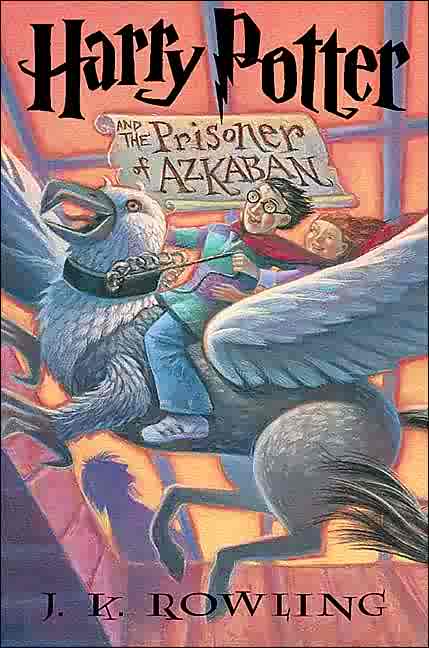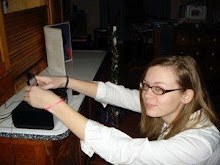 Harry Potter and the Prisoner of Azkaban by JK Rowling
Harry Potter and the Prisoner of Azkaban by JK RowlingMay 2009 (re-read)
Every time that I've re-read the Harry Potter series, I secretly fear that the books lose some of their magic for me. I'm afraid that after 10 years and countless re-readings, I won't love them as much anymore, that they'll just become stories from my childhood. Luckily, these fears have never been realized. In fact, it seems as if every time I read the books, I discover something new, or rediscover something that I'd forgotten.
This was probably my 6th or 7th reading of this book, the third in the series. What struck me this time was the true complexity of the plot, as well as its relation to the rest of the series. I like the first two Harry Potter books and their content definitely plays a big role in the rest of the series. But when one first reads Sorcerer's Stone and Chamber of Secrets, they seem to be simple, self-contained stories, wrapped up nicely at the end with Harry's success. Things change in Prisoner of Azkaban. So many questions have arisen by the end of the book, I find myself clamoring to read on, even though I already know what happens. But for a first time reader, the intrigue must be torturous. Harry, Ron, and Hermione's success isn't as tidy in this book. Yes, they freed Sirius Black before he received the Dementor's Kiss, but Peter Pettigrew also went free. Without him as evidence, Sirius will never live a normal life; he will always be wanted by the Ministry for a crime he didn't commit. We, as readers, are left to ask ourselves: What happens to Sirius now? Will he remain in hiding with Buckbeak, the hippogriff? Did Peter Pettigrew return to Lord Voldemort? Will he help Voldemort to rise again? We must continue reading the books to receive the answers to these questions.
Not only does J.K. Rowling leave Prisoner of Azkaban open to be connected to further novels, she weaves a complex, yet self-contained plot in this book. Cleverly introducing the concept of the Animagus in Harry's first Transfiguration lesson of the year, Rowling sets up the revelation of Sirius's identity as an Animagus. Simultaneously, we see Harry catch glimpses of Sirius throughout the school year,his Divination lessons causing him to think that the big black dog is an omen of his death. The best part of discovering that Sirius is the dog is that we know J.K. Rowling had planned it from the beginning of the series. She didn't just sit down to write Prisoner of Azkaban and decide that Sirius should turn into a canine. A brief mention of Sirius Black's name in the first chapter of Sorcerer's Stone introduced us to the character. But a dip into onomatology reveals that in astronomy Sirius is the brightest star in the night sky and often called the "Dog Star." Throw in the fact that Sirius's last name is Black, corresponding with the color of his Animagus form. Coincidence? J.K. Rowling thinks not.
In fact, nothing is a coincidence in the Harry Potter series. Ron Weasley doesn't just use Scabbers because he was a hand-me-down pet; he owns Scabbers because Scabbers is Peter Pettigrew and Peter Pettigrew is the reason Sirius spent 12 years in Azkaban prison. Buckbeak didn't attack Draco Malfoy in their first Care of Magical Creatures lesson for fun; Buckbeak attacked Draco Malfoy so that he would later save Sirius. There are no insignificant events; Chekhov's gun always goes off in the Harry Potter series.
The use of time-travel is nothing new to fantasy stories. We've all seen Back to the Future, we know the beauty of traveling through time and the risks it requires. But there's something completely genius about Rowling's use of the time turner. The reader knows that something has been going on with Hermione. Ron's constant curiosity about how she seems to be in two places at the same time strikes a cord with us. But with the action in the Shrieking Shack, Hermione's schedule is completely out of our minds. Until, Dumbledore's cryptic comment that, "what we need is more time" (393). Now, as Hermione and Harry are thrown three hours into the past, we realize that Hermione's secret is what will save Sirius.
Concluding that they must save Buckbeak in order to provide an escape for Sirius, Harry and Hermione sneak down to Hagrid's hut, avoiding being seen by themselves in the past. Allowing for the executioner to see with his own eyes that Buckbeak is tethered in the yard, they then lure the hippogriff into the trees at the edge of the Forbidden Forest. In a rage at discovery the hippogriff's disappearance, the executioner slam's his axe into the nearby fence. This, we realize, is the sound we heard earlier, assuming it to be the axe killing Buckbeak.
Despite Harry's wishes to change things in the past, Hermione is steadfast; they cannot be seen. The temptation is great. Harry wants to snatch up Pettigrew while he has the chance. He wants to stop Snape from using his Invisibility Cloak. He wants to do something. And he gets his chance. Watching a swarm of dementors attack himself, Sirius, and Hermione, Harry awaits the person that he saw rescue them earlier

. Thinking that his dead father will appear to conjure a patronus, Harry eventually realizes it was himself who he saw conjure the patronus. We knew that James Potter didn't conjure the patronus when Harry first saw the figure across the lake, but we didn't realize until this moment that the time turner had allowed Harry to rescue himself, along with Hermione and Sirius. Now, the time comes for Sirius's escape. Once Snape has sent him up to the castle and he is locked away in Flitwick's office, Harry and Hermione stage their rescue. They fly the fugitive hippogriff up to the window, send Sirius and Buckbeak off into the night, and race to return to the hospital wing, where they had started from.
We have to give props to Dumbledore. We knew that he had shrewd insight into the goings-on at Hogwarts. But Dumbledore knew instantly what measures needed to be taken to ensure the safety of Black and Buckbeak. With a few meaningful words to the pair, "if all goes well, you will be able to save more than one innocent life tonight" (393), he informs Harry and Hermione of what they must do.
J.K. Rowling planned every sentence of this novel to a t. Nothing happens for no reason. From Sirius's mention on the muggle news to seeing the grim on a book cover to Neville writing down Gryffindor's passwords to the discovery of the Marauders' Map; everything is significant and everything plays a part in the plot as a whole. Harry Potter and the Prisoner of Azkaban is a magnificent piece of Harry's story, tying in the previous two novels and setting up the action of the remaining four. Readers must know what happens next and as Ron Weasley informs Harry, they have the World Cup to look forward to...



